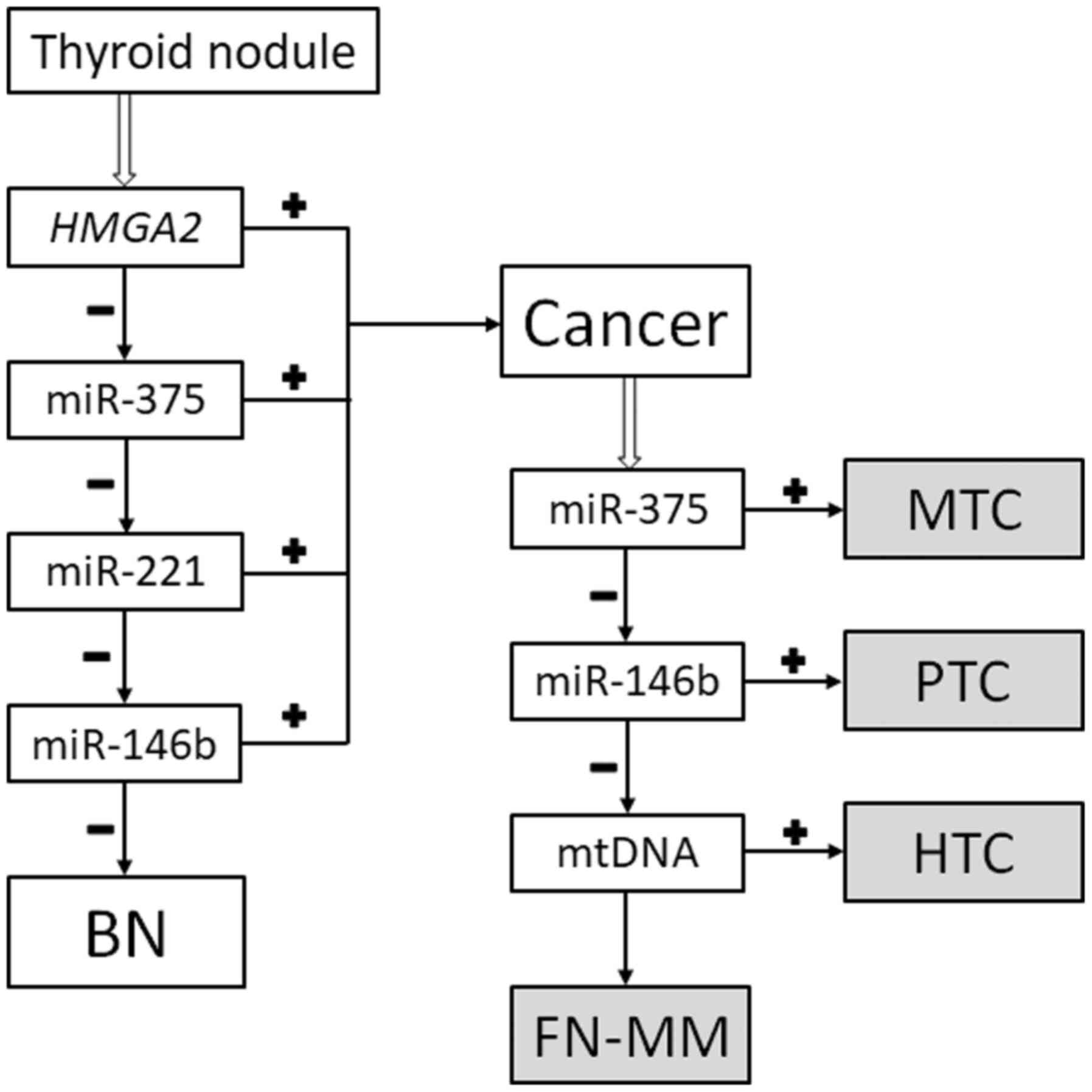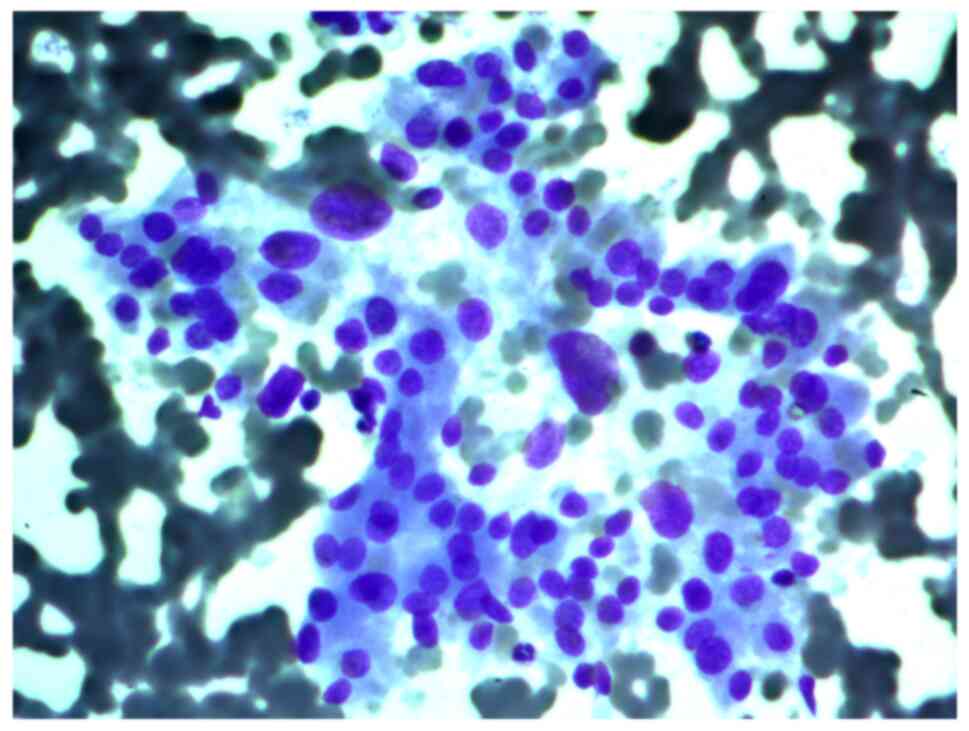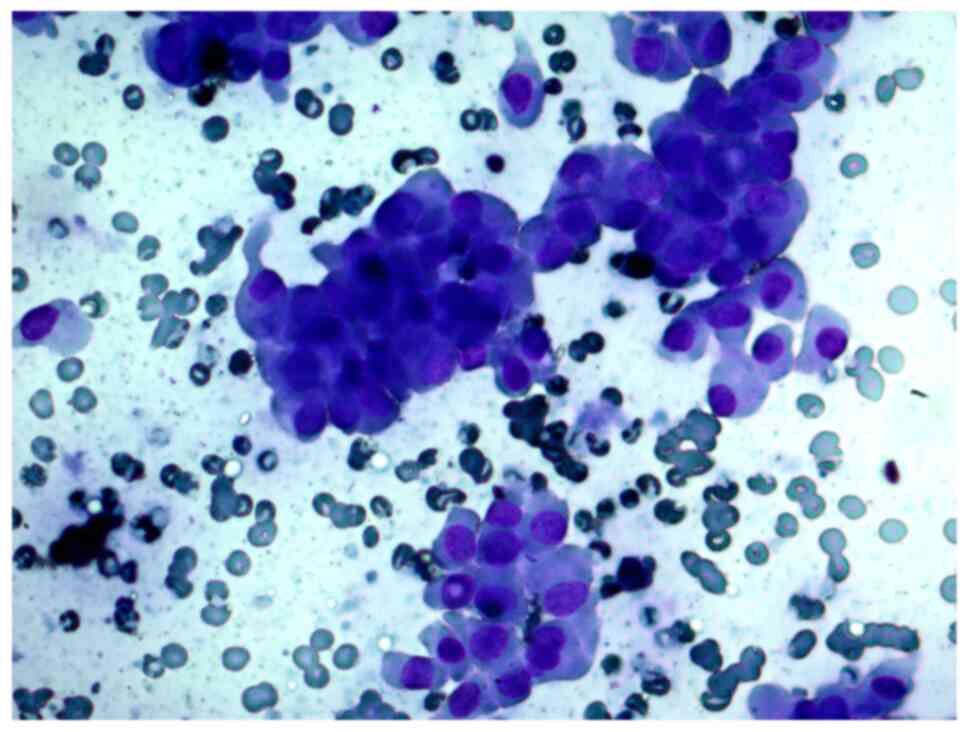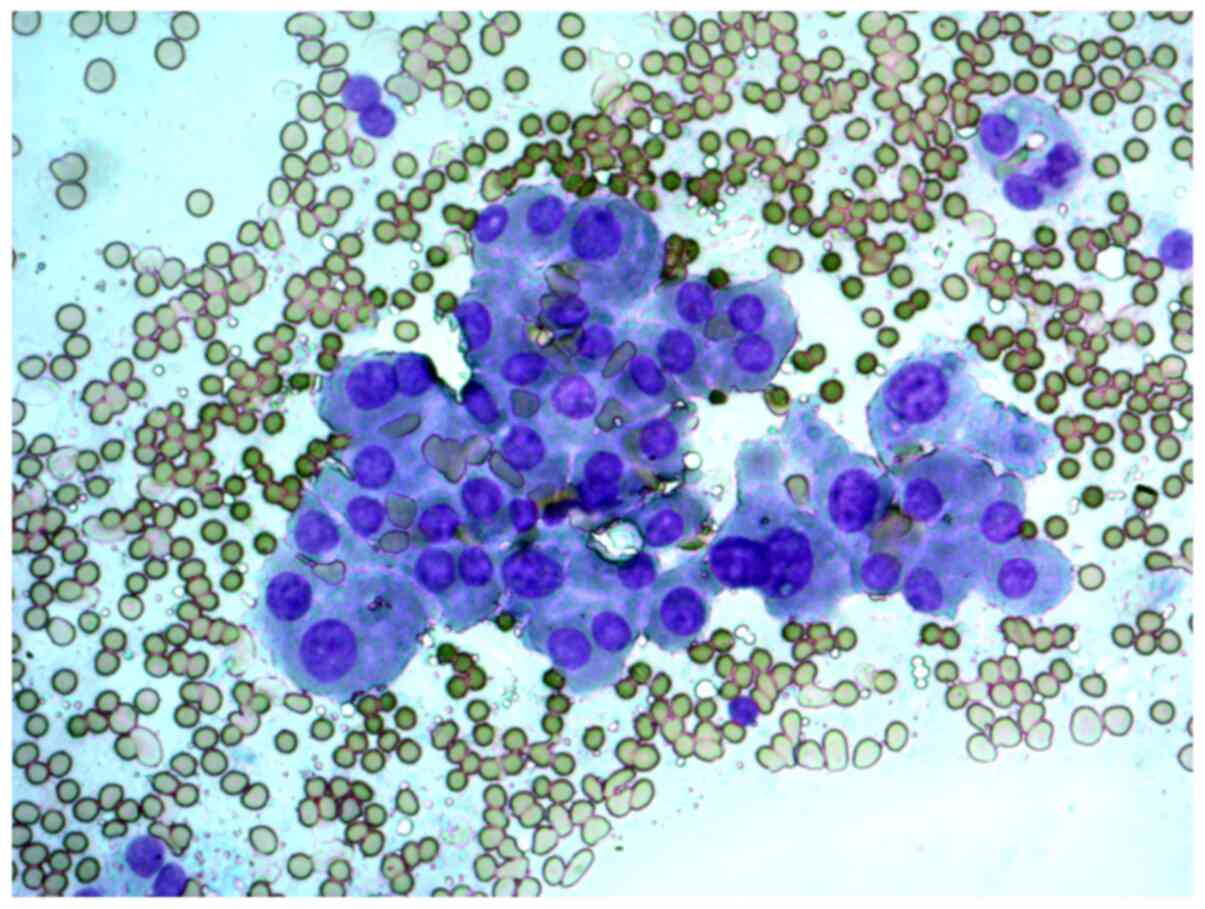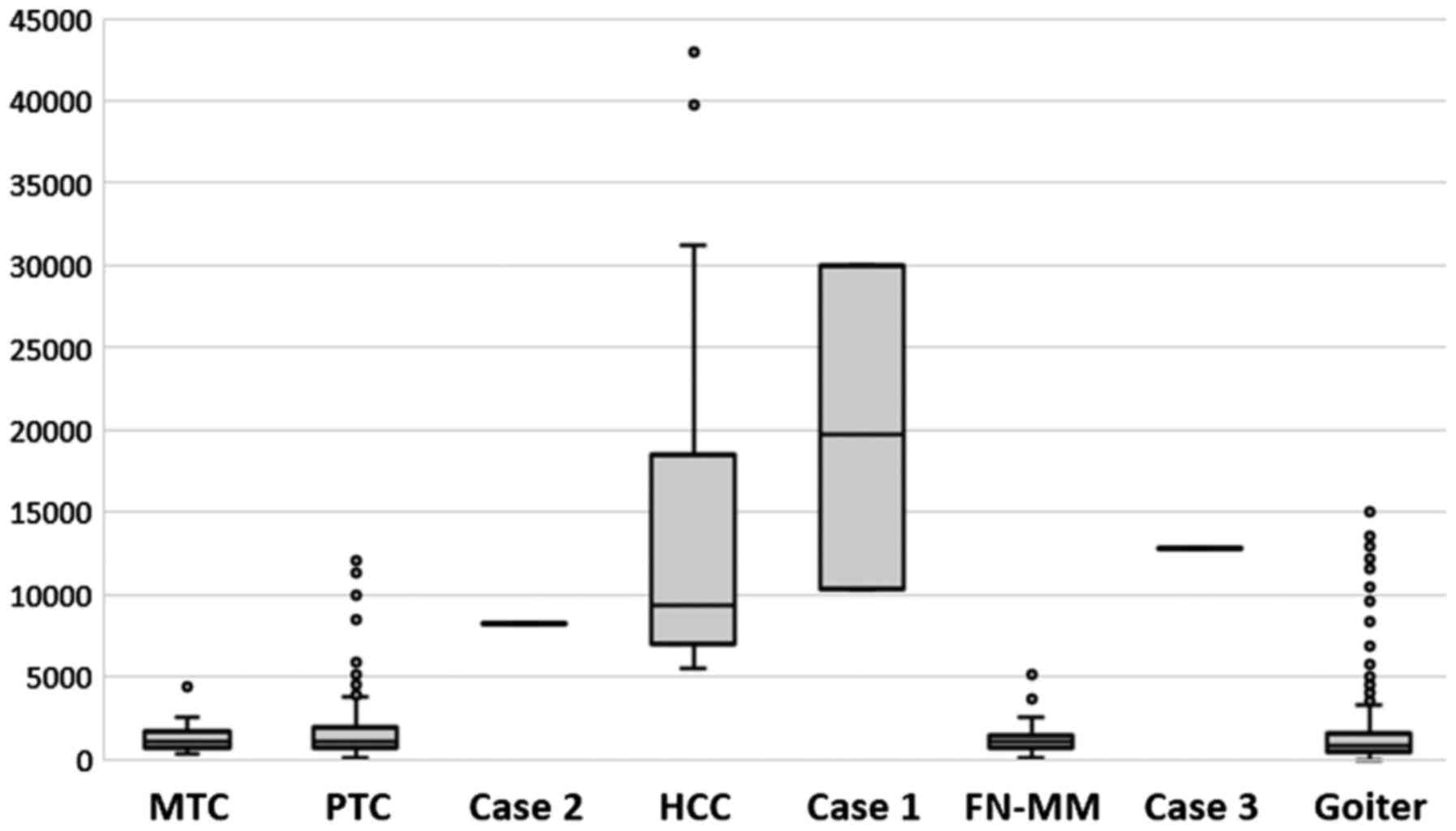Cytological and molecular diagnosis of Hürthle cell thyroid tumors: Analysis of three cases
- Authors:
- Published online on: May 28, 2021 https://doi.org/10.3892/mco.2021.2311
- Article Number: 149
-
Copyright: © Titov et al. This is an open access article distributed under the terms of Creative Commons Attribution License.
Abstract
Introduction
Cytological examination of the thyroid gland by fine-needle aspiration biopsy (FNAB) of thyroid nodules is important for the verification of a pathology and for differential diagnosis between benign nodular neoplasms and malignant tumors (1-3).
Differential diagnosis of Hürthle cell (oncocytic) tumors of the thyroid gland represents a special problem. Hürthle cells are normally associated with lymphocytic thyroiditis (Hashimoto's disease) and multinodular goiters; however, these cells can also give rise to such tumors as Hürthle cell adenoma (HCA) and Hürthle cell carcinoma (HCC). The WHO Classification of Tumors has singled out HCA and HCC as nosological entities other than follicular tumors, because of morphological and genetic differences between these tumors (4). According to the Bethesda System for Reporting Thyroid Cytopathology 2018, HCA and HCC are in diagnostic category IV (suspicious for a follicular neoplasm), with molecular testing or surgical lobectomy recommended (1).
A typical feature of tumors that grow from Hürthle cells is that cellular atypia does not necessarily mean malignancy (1,5,6). FNAB material appears to consist exclusively of Hürthle cells with abundant finely granular cytoplasm, an enlarged central or eccentric round nucleus, and prominent nucleolus. Some cells are stand-alone entities, and others are in syncytial-like sheets. The oncocytes vary in size from giant cells to small monomorphic cells with a high nuclear-to-cytoplasmic ratio. Some cells feature marked anisonucleosis: A large hyperchromic nucleus with irregular contours of the nuclear membrane, sometimes with nuclear grooves and pseudo-inclusions.
As mentioned above, nuclear atypia, which is indicative of Hürthle cells, is by itself not a criterion for malignancy of a tumor. Hürthle cell patterns should be distinguished between nontumors (Hashimoto's disease and multinodular goiters) and tumors, including papillary thyroid carcinoma, follicular thyroid carcinoma, and medullary thyroid carcinoma. Cytologically, HCA and HCC are identical; accordingly, the diagnosis can be made only after histological examination following nodule resection. Consequently, due to additional molecular oncomarkers in FNAB, clinical decision making is expected to become easier, and prognoses may become more accurate.
Over the past decade, it has been demonstrated that microRNAs (miRNAs, miRs)-short (18- to 24-nucleotide-long) RNA molecules with an important role in post-transcriptional regulation of a large number of genes-can be used as biological oncomarkers (7-9). Levels of many miRNAs are substantially altered in diverse tumors, including thyroid neoplasms (10-12). Isolation and profiling of miRNA in the material used for cytological examination of thyroid nodules can improve diagnostic accuracy when combined with the cytological method of diagnosis.
In a recent study we described our original diagnostic algorithm to identify and type malignant thyroid tumors (including HCC) via analysis of a small number of molecular markers in FNAC preparations (levels of HMGA2 mRNA and miR-375, -221, and -146b in combination with the mitochondrial-to-nuclear DNA ratio) (13). It has already been validated on 122 samples (14), but at this validation, we did not focus on Hürthle cell tumors.
The aim of the present study was to assess the effectiveness of the same algorithm at detecting Hürthle cell thyroid tumors in three well-characterized samples obtained by FNAB and used for cytological examination.
Materials and methods
Clinical material
A cytological examination of the FNAB material and intraoperative imprint cytological analysis of the thyroid lesions were performed for three patients with nodular neoplasms. The cytological smears and intraoperative imprints was air-dried and stained by a standard procedure [May-Grünwald-Giemsa (MGG) staining]. Histological analysis of surgically removed thyroid tissue was conducted by staining tissue sections (5-µm thick) with hematoxylin and eosin. Briefly, after resection of the thyroid lobe, the tissue is fixed in formalin for 24 h at room temperature then histological processing of the tissue was carried out using vacuum infiltration processor Tissue-Tek® VIP™ 6 (Sakura Finetek Europe B.V., The Netherlands) with the routine overnight run program (processing time: 12.7 h, temp=40-58˚C). After sectioning of the paraffin-embedded tissue, the sections were manually stained with hematoxylin (NPF ABRIS+) and eosin (ErgoProduction), following a basic protocol: Dewaxing (with xylene), dehydration (ethanol then water), hematoxylin (10 min), differentiation (acid alcohol), bluing (aqueous ammonium hydroxide), eosin (5 min), dehydration (ethanol then water), clearing (xylene), cover-slipping. The preparations were examined under a light microscope with a magnification of 100 and 400. The preparations were examined under a light microscope with a magnification of 100 and 400. The histological and cytological material was obtained in accordance with Russian laws and regulations; all data were depersonalized.
Total-nucleic-acid isolation
Nucleic acid was isolated from the cytological preparations (reviewed in ref. 13). The dried cytological preparation was washed into a microcentrifuge tube with three 200 µl portions of guanidine lysis buffer, then the sample was vigorously mixed and incubated in a thermal shaker for 15 min at 65˚C. Next, an equal volume of isopropanol was added. The reaction solution was thoroughly mixed and kept at room temperature for 5 min. After centrifugation for 10 min at 14,00 x g, the supernatant was discarded, and the pellet was washed with 500 µl of 70% ethanol and 300 µl of acetone. Finally, the RNA was dissolved in 200 µl of deionized water. If not analyzed immediately, RNA samples were stored at -20˚C until further use.
Molecular analysis
Assessment of relative expression levels of the HMGA2 gene (normalized to housekeeping gene PGK1), miR-146b, -221, and -375 (normalized to the geometric mean of miR-29b, -23a, and -197 levels) and calculation of the ratio of mitochondrial DNA (mtDNA) to nuclear DNA (nDNA) were done as described previously (13). The details are presented below.
MiRNA detection and quantitation
The detection of the 6 miRNAs was performed on three samples of oncocytic tumors. To quantify miRNA, we followed the protocol published by Chen et al in 2005, which includes reverse transcription of mature miRNA using a long stem-loop primer followed by the detection of cDNA via real-time PCR (15). Reverse-transcription reactions were set up individually for each miRNA to be quantified. The obtained cDNA was subjected to further PCR analysis immediately. The reverse-transcription reaction and real-time PCR were carried out (reviewed in ref. 16). The miRNA content was normalized to the geometric mean of the amounts of the three reference miRNAs by the 2-ΔCq method (17).
Quantification of HMGA2 mRNA
The relative concentration of HMGA2 mRNA was estimated by real-time RT-PCR, where PGK1 (phosphoglycerate kinase 1) mRNA served for normalization. The following RT-PCR program was employed: Incubation for 30 min at 45˚C, preheating for 2 min at 95˚C, and then 50 cycles of denaturation for 10 sec at 94˚C with annealing and elongation for 20 sec at 60˚C (13). The relative expression level was calculated by the 2-ΔCq method.
Determination of the mtDNA/nDNA ratio
Detection of specific sites in mtDNA and nDNA was performed independently by real-time PCR. The thermal cycling conditions were as follows: Preheating for 2 min at 95˚C, then 50 cycles of denaturation for 10 sec at 94˚C with annealing and elongation for 20 sec at 60˚C (13). The ratio was determined with the 2-ΔCq method.
The classifier
The classification method (reviewed in ref. 13) was used (Fig. 1). Thus, the specimens are classified as either benign (goiters and follicular neoplasms without markers of malignancy) or malignant (papillary thyroid carcinoma, medullary thyroid carcinoma, HCC, and a follicular neoplasm with markers of malignancy). Additionally, the ratio of mtDNA to nDNA allows to determine whether a given case of papillary thyroid carcinoma can be categorized as the Hürthle cell type.
Results
Case 1
Aspirates of FNAB from a 34-year-old female patient with a 2 cm nodule in the left thyroid lobe were investigated. The cytological report stated that this was a Hürthle cell (oncocytic) neoplasm, and that in the studied samples, there were groups of Hürthle cells of various sizes, with subpopulations showing pronounced polymorphism, abundant fine-grained cytoplasm, an eccentrically or centrally located nucleus, and enlarged nucleolus (Figs. 2 and 3).
Three slides were examined, and the results are given in Table I; our final opinion was HCC. The histological report on the surgical material indicated that this was Hürthle cell (oncocytic) thyroid carcinoma, and that the trabecular structure prevailed in the tumor tissue, with minimal invasive growth into the capsule. The report also stated that the Hürthle cells that formed the tumor featured pronounced cellular and nuclear polymorphism, eosinophilic granular cytoplasm, and enlarged nucleoli.
Case 2
FNAB was performed on a 56-year-old female patient with a thyroid nodule. The cytological report indicated a suspected Hürthle cell (oncocytic) neoplasm and that the cellular aspirate consisted of cells with oncocytic signs, forming sporadic papillary structures; some cells had features characteristic of papillary carcinoma: Uneven nuclear contours and nuclear grooves. According to the cytological report, papillary thyroid carcinoma could not be ruled out (Figs. 4 and 5).
One slide was examined; the results are listed in Table II; our conclusion is Hürthle cell papillary thyroid carcinoma.
Total thyroidectomy was performed. The histological report stated that this was papillary thyroid carcinoma, and that the tumor tissue was predominantly papillar. Tumor cells belonged to the oncocytic type, with abundant eosinophilic granular cytoplasm and a moderately polymorphic nucleus with typical signs of papillary cancer. According to the report, the tumor showed invasive capsular growth, and there were regional lymph node metastases.
Case 3
A 29-year-old woman with a solitary thyroid nodule in the right lobe. The cytological report on the FNAB samples indicated that this was a suspected Hürthle cell (oncocytic) neoplasm, and that in cytological samples, there were syncytial-like sheets and clusters of Hürthle cells with moderate cellular and nuclear polymorphism (Figs. 6 and 7).
One slide was examined; the results are presented in Table III; we concluded that this is a benign Hürthle cell tumor.
Surgical lobectomy was performed. The histological report stated that this was oncocytic adenoma, i.e., an encapsulated tumor with a solid and trabecular structure, consisting of cells of the oncocytic type, with abundant eosinophilic granular cytoplasm, a large nucleus, and enlarged nucleolus. According to this report, no capsular or vascular invasion was found.
We verified the validity of all the above reports. In the cases presented, the ratio of mtDNA to nDNA, which is a marker of Hürthle cells, was within previously described ranges (13) and helped to make the diagnoses (Fig. 8).
Discussion
In our recent study, we proposed an original version of the diagnostic algorithm that identifies and types malignant thyroid tumors via analysis of molecular markers in cytological preparations. This algorithm involves the ratio of mtDNA to nDNA as a criterion for the presence of Hürthle cells because these cells, according to the literature (18) and our original data, contain many more mitochondria than follicular cells do. This is apparently because at least in the thyroid gland, Hürthle cells exhibit decreased cellular performance (19). These data suggest a defect in the energy production machinery of the cells and indicate that the increased mitochondrial content may be compensatory.
It is now generally accepted that almost all histological types of benign and malignant thyroid tumors have a Hürthle cell counterpart (20). In these tumors, the Hürthle cell appearance is thought to represent a phenotype that is superimposed on the genotypic and conventional histopathologic features of the tumors. After the recognition of the clinicopathologic and genetic differences between PTC and FTC composed of Hürthle cells, it has been generally accepted that the Hürthle cell variant of PTC should be referred to as such, whereas the Hürthle cell variant of FTC may be designated simply as HCC (21) (the same implicitly follows from Fig. 7, if we compare the mtDNA content between FN-MM and HCC). It should be emphasized that the preoperative detection of FTC is a complex diagnostic problem, but our proposed algorithm allows this to be done reasonably accurately at least for the Hürthle cell variant of FTC (i.e., HCC).
Therefore, elevated mtDNA content of a tissue sample is indicative of Hürthle cells but not of malignancy. The hallmark of HCC is overexpression of miR-221. Although this upregulation alone is not unique to HCC, its combination with elevated mtDNA content is. This diagnostic algorithm can be applied to any cytological slides but primarily to Bethesda categories III and IV. The limitations of this method are the same as those for cytological analysis: An insufficient cell number in a sample and contamination with blood. These limitations may distort the result or prevent it from being obtained, however, this method is supposed to be used for samples that have already been analyzed by a cytologist, so that unsuitable samples will not be tested by our diagnostic algorithm.
At the moment, there is another diagnostic test that enables clinicians to identify benign and malignant Hürthle cell tumors: The Afirma Genomic Sequencing Classifier (GSC), which involves next-generation RNA sequencing. To identify Hürthle cell tumors, the GSC system includes two components: Hürthle cell index-mRNA expression plus mitochondrial transcripts as well as Hürthle neoplasm index-mRNA expression plus chromosomal level of loss of heterozygosity (22). Thus, just as in our algorithm, in the GSC, an estimate of the number of mitochondria is used to identify Hürthle cells (via determination of expression levels of mitochondrial genes). In contrast, malignancy is determined differently, through the assessment of genetic instability, whereas in our version, this is done via evaluation of the expression of miR-221, which is a simpler approach.
The main limitation of this study is the small number of samples involved (three). This is due to the relative rarity of Hürthle cell tumors, but this number is planned to increase over time. As far as the analyzed cases are concerned, the use of molecular markers in the analysis of cytological material helped to make a correct diagnosis preoperatively, demonstrating potential usefulness of this approach for addressing and solving cytologically unclear or ambivalent cases.
Acknowledgements
Not applicable.
Funding
The present study was supported by the Russian Science Foundation (grant no. 20-14-00074).
Availability of data and materials
The datasets used and/or analyzed during the current study are available from the corresponding author on request.
Authors' contributions
ST and TLP conceived the current study. TLP and VVA collected patient samples. ST, YAV, and TLP conducted the experiments. ST and TLP wrote the manuscript. VVA and YAV revised the manuscript. VVA interpreted the data and gave final approval for the manuscript to be published. All the authors read and approved the final manuscript.
Ethics approval and consent to participate
The Ethical Committee of the Clinical Hospital RZD-Medicine approved the study protocol. The procedures in the present study adhere to the tenets of the Declaration of Helsinki. Written informed consent was obtained from all the participating patients.
Patient consent for publication
Not applicable.
Competing interests
The authors declare that they have no competing interests.
References
|
Ali SZ and Cibas ES (eds.): The Bethesda System for Reporting Thyroid Cytopathology. Springer, New York, NY, 2018. | |
|
Baloch ZW, LiVolshi VA, Asa SL, Rosai J, Merino MJ, Randolph G, Vielh P, DeMay RM, Sidawy MK and Frable WJ: Diagnostic terminology and morphologic criteria for cytologic diagnosis of thyroid lesions: A synopsis of the national cancer institute thyroid fine-needle aspiration state of the science conference. Diagn Cytopathol. 36:425–437. 2008.PubMed/NCBI View Article : Google Scholar | |
|
Nguyen GK, Lee MW, Ginsberg J, Wragg T and Bilodeau D: Fine-needle aspiration of the thyroid: An overview. Cytojournal. 2(12)2005.PubMed/NCBI View Article : Google Scholar | |
|
Lloyd RV, Osamura RY, Klöppel G and Rosai J (eds): WHO Classification of Tumours of Endocrine Organs. IARC, Lyon, 2017. | |
|
Montone KT, Baloch ZW and LiVolsi VA: The thyroid Hürthle (oncocytic) cell and its associated pathologic conditions: A surgical pathology and cytopathology review. Arch Pathol Lab Med. 132:1241–1250. 2008.PubMed/NCBI View Article : Google Scholar | |
|
Nikiforov YE, Biddinger PW, Thompson LDR and Nikiforova MN (eds): Diagnostic Pathology and Molecular Genetics of the Thyroid. Lippincott Williams & Wilkins, Piladelphia, PA, 2009. | |
|
Lagos-Quintana M, Rauhut R, Lendeckel W and Tuschl T: Identification of novel genes coding for small expressed RNAs. Science. 294:853–858. 2001.PubMed/NCBI View Article : Google Scholar | |
|
Wang J, Chen J and Sen S: MicroRNA as biomarkers and diagnostics. J Cell Physiol. 231:25–30. 2016.PubMed/NCBI View Article : Google Scholar | |
|
Nikiforova MN, Tseng GC, Steward D, Diorio D and Nikiforov YE: MicroRNA expression profiling of thyroid tumors: Biological significance and diagnostic utility. J Clin Endocrinol Metab. 93:1600–1608. 2008.PubMed/NCBI View Article : Google Scholar | |
|
Cancer Genome Atlas Research Network. Integrated genomic characterization of papillary thyroid carcinoma. Cell. 159:676–690. 2014.PubMed/NCBI View Article : Google Scholar | |
|
Pallante P, Battista S, Pierantoni GM and Fusco A: Deregulation of microRNA expression in thyroid neoplasias. Nat Rev Endocrinol. 10:88–101. 2014.PubMed/NCBI View Article : Google Scholar | |
|
Swierniak M, Wojcicka A, Czetwertynska M, Stachlewska E, Maciag M, Wiechno W, Gornicka B, Bogdanska M, Koperski L, de la Chapelle A and Jazdzewski K: In-depth characterization of the microRNA transcriptome in normal thyroid and papillary thyroid carcinoma. J Clin Endocrinol Metab. 98:E1401–E1409. 2013.PubMed/NCBI View Article : Google Scholar | |
|
Titov SE, Ivanov MK, Demenkov PS, Katanyan GA, Kozorezova ES, Malek AV, Veryaskina YA and Zhimulev IF: Combined quantitation of HMGA2 mRNA, microRNAs, and mitochondrial-DNA content enables the identification and typing of thyroid tumors in fine-needle aspiration smears. BMC Cancer. 19(1010)2019.PubMed/NCBI View Article : Google Scholar | |
|
Titov S, Demenkov PS, Lukyanov SA, Sergiyko SV, Katanyan GA, Veryaskina YA and Ivanov MK: Preoperative detection of malignancy in fine-needle aspiration cytology (FNAC) smears with indeterminate cytology (Bethesda III, IV) by a combined molecular classifier. J Clin Pathol. 73:722–727. 2020.PubMed/NCBI View Article : Google Scholar | |
|
Chen C, Ridzon DA, Broomer AJ, Zhou Z, Lee DH, Nguyen JT, Barbisin M, Xu NL, Mahuvakar VR, Andersen MR, et al: Real-time quantification of microRNAs by stem-loop RT-PCR. Nucleic Acids Res. 33(e179)2005.PubMed/NCBI View Article : Google Scholar | |
|
Titov SE, Ivanov MK, Karpinskaya EV, Tsivlikova EV, Shevchenko SP, Veryaskina YA, Akhmerova LG, Poloz TL, Klimova OA, Gulyaeva LF, et al: miRNA profiling, detection of BRAF V600E mutation and RET-PTC1 translocation in patients from Novosibirsk oblast (Russia) with different types of thyroid tumors. BMC Cancer. 16(201)2016.PubMed/NCBI View Article : Google Scholar | |
|
Livak KJ and Schmittgen TD: Analysis of relative gene expression data using real-time quantitative PCR and the 2(-Delta Delta C(T)) method. Methods. 25:402–408. 2001.PubMed/NCBI View Article : Google Scholar | |
|
Cannon J: The Significance of Hürthle Cells in Thyroid Disease. Oncologist. 16:1380–1387. 2011.PubMed/NCBI View Article : Google Scholar | |
|
Valenta LJ, Michel-Bechet M, Warshaw JB and Maloof F: Human thyroid tumors composed of mitochondrion-rich cells: Electron microscopic and biochemical findings. J Clin Endocrinol Metab. 39:719–733. 1974.PubMed/NCBI View Article : Google Scholar | |
|
Sobrinho-Simoes M, Asa SL, Kroll TG, Nikiforov YE, DeLellis RA, Farid P, Kitamura Y, Noguchi S, Eng C, Harach HR, et al: Follicular carcinoma. In: World Health Organization Classification of Tumours. Pathology and Genetics of Tumours of Endocrine Organs. deLellis RA, Lloyd RV, Heitz PU and Eng C (eds). IARC Press, Lyon, pp 67-72, 2004. | |
|
Máximo V, Lima J, Prazeres H, Soares P and Sobrinho-Simões M: The biology and the genetics of Hurthle cell tumors of the thyroid. Endocr Relat Cancer. 19:R131–R147. 2012.PubMed/NCBI View Article : Google Scholar | |
|
Patel KN, Angell TE, Babiarz J, Barth NM, Blevins T, Duh QY, Ghossein RA, Harrell RM, Huang J, Kennedy GC, et al: Performance of a genomic sequencing classifier for the preoperative diagnosis of cytologically indeterminate thyroid nodules. JAMA Surg. 153:817–824. 2018.PubMed/NCBI View Article : Google Scholar |



